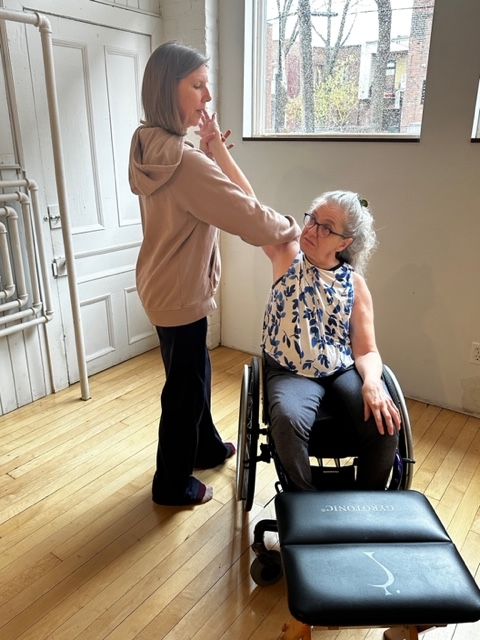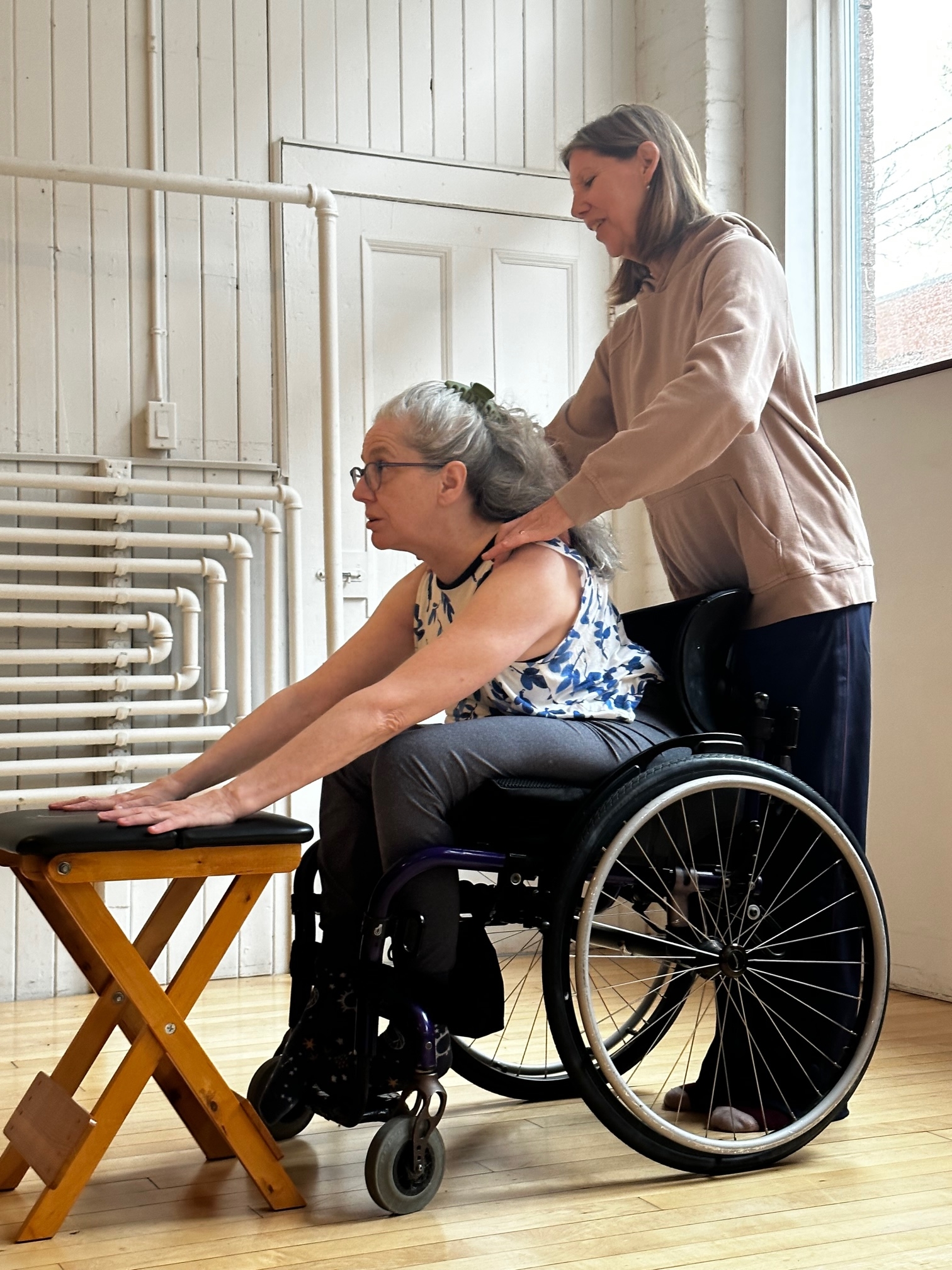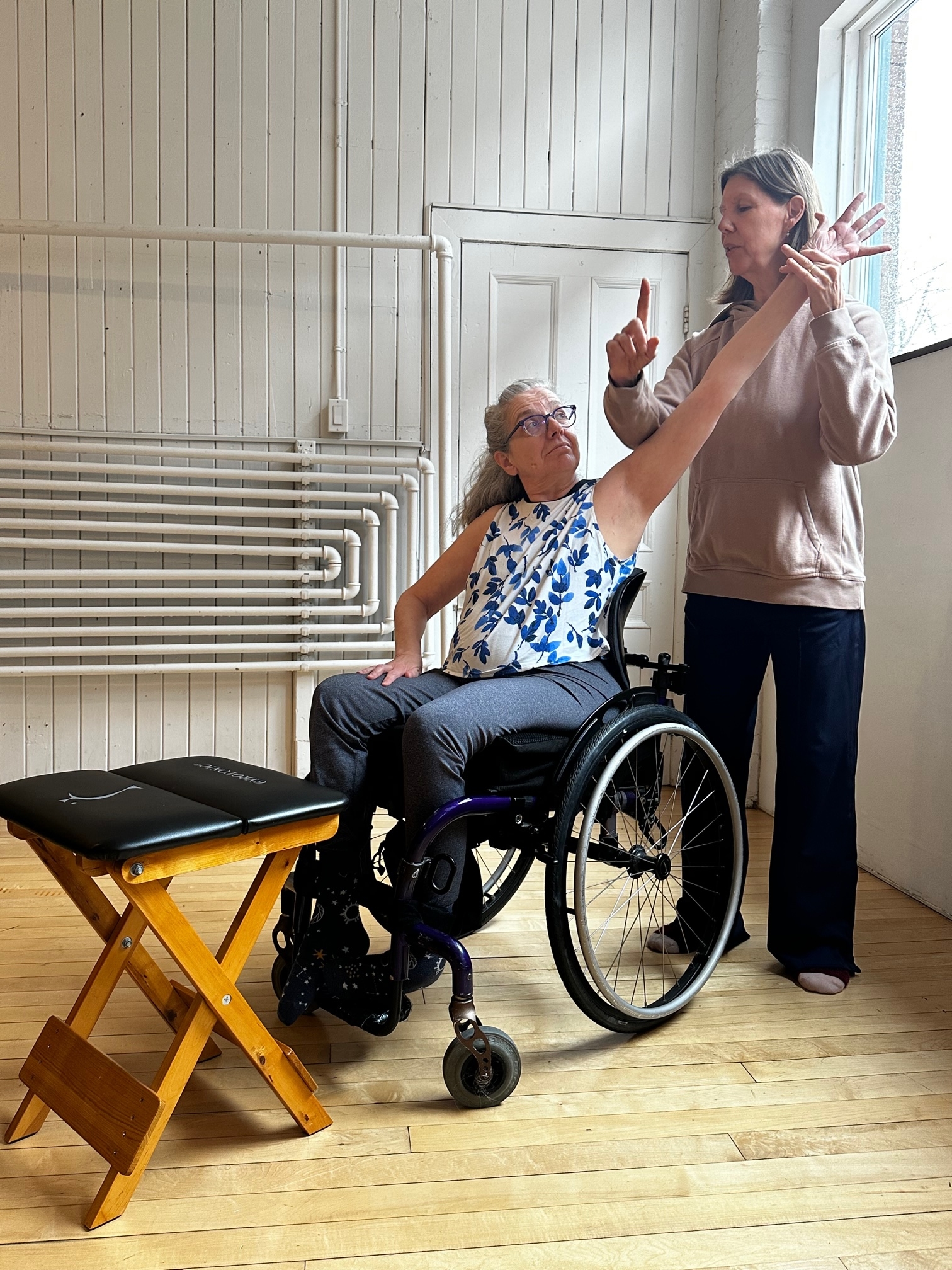Finding Possibilities: Teacher Training for the GYROKINESIS® Method in a Wheelchair
Blog Content Interviews // July 19, 2023
Dana Gingras is a renowned choreographer, filmmaker, performer and a specialized GYROKINESIS® and GYROTONIC® Master Trainer. She is the Master Trainer for Liz Winklaar, a Gyrokinesis Level 1 Trainer. We asked her to share her experience working with Liz and adapting the material for her training and practice. You can read more about Liz, here.
Cina: Dana, thank you for sharing your experience with us. How did you meet Liz and what was your first impression of how it was going to work
Dana: I met Liz through a pre-trainer in my network Siôned Watkins who is in Ottawa. Siôned had been teaching Gyrokinesis to Liz through a diverse abilities dance company called Propeller Dance. Liz became very passionate about her experience with Gyrokinesis. Then Siôned approached me and said, “Do you think Liz could possibly do the Gyrokinesis Foundation Course?” I think I spoke to Gina [Educational Assistant to Juliu Horvath] about it and she was given approval to do it and that’s how she got started.
So, she did the pre-training with Siôned and then we did the Foundation, Apprentice Review and Certification together. I was super curious about how to work with Liz and her abilities. I love what’s possible. So it was never about limitation, but what was possible with Liz. What was remarkable was seeing her transformation over the nine-day foundation course. She looked like a completely different person. It’s like she’d reversed aging by 15 years. She had so much light in her eyes and you could feel this vitality flowing. It was so incredibly moving and touching to see that transformation, and her willingness to go through the process was inspiring. She was so open and accessible.

Master Trainer Dana Gingras in a session with Trainer Liz Winklaar
Her boundaries are also very clear. This made it was easier in terms of figuring out how we would adapt the material and what principles we were using to support the work. I really started with the idea that energy follows intention. Tracking what the eyes were doing. We started there and then looked at how the spine was able to follow through. Also, what was she able to feel or not? Following the areas where there was sensation became a key. She can still engage her bladder, so narrowing using the wheelchair for leverage was possible. Basically, the armrests and wheels of the wheelchair became her feet so she could press down using her hands. Sequences that involved pure legwork we worked on a choreography where she could demonstrate with her arms. So, if there were things she was unable to physically do, she would demonstrate, she had the queuing.
So, for me, that’s really creative as well. Thinking through these things and problem-solving. I loved breaking the material down. Ultimately, you see how Gyrokinesis is an energetic practice. Of course, it’s a physical practice, but the opening and movement through the energy channels, the stimulation of the nervous system and breaking up stagnation, I witnessed this firsthand, and what that can do. It was very profound. We even did things like suppling where we helped Liz out of her chair to the ground. She was just delighted in terms of the effects of being suppled and having that experience. It was, such a learning curve and such a gift working with her, I must say.
Cina: I find it remarkable. I’m wondering, since you are a choreographer, if some of that came into play when figuring out what movements were best.
Dana: Yeah, completely because where movement isn’t possible, it was about creating a whole sign language in a sense that would be clear to the students that she teaches. She teaches very mixed-ability classes, so there needs to be a way to translate the movement. Sometimes Siôned assists and demonstrates for her, but still, the cueing has to be very clear and precise. There’s no getting lost in anything extra. It becomes very distilled, like what is happening in each exercise, why we are doing it, what is the purpose, and where is the balance. I love having to look at the two Gyrokinesis formats from a different bodily perspective.
Cina: That must have been so enriching for you on some level because you’ve been in the work for so long. Having to frame it in such a new way must have been inspirational as well.
Dana: Absolutely. And her spirit, I have to say, this brightness and willingness to pursue this path. How can you not meet that excitement, right?
Cina: Juliu talks a lot about the necessity to understand the intention behind everything we do, especially with hands-on, which seemed to play a significant role in working with Liz.

Master Trainer Dana Gingras working with Trainer Liz Winklaar
Dana: Yes, and for her to experience hands-on in class, of course, that really gives the body a nice imprint and supportive direction. It’s such a great guide in terms of what we are searching for and exploring. Liz was very clear at giving feedback about her experience: “Well actually if I do it this way – if I go over the back of the chair in an arch, this is what I experience.” So, I was also relying on a lot of feedback from her in relation to what she was experiencing to be able to really refine the adaptations. It was beautiful for things like the standing Figure 8s that we do where we are moving at the end of class or in the twirling, she was doing that all moving through space with the wheelchair. That was incredible because it was a whole wheelchair choreography in itself.
Cina: So, we have another trainer in a wheelchair, Lorenzo Spadafora, who is a Gyrotonic Trainer in Italy, and it was interesting talking with his Master Trainer, Igor Abba, about what specific exercises he was able to use to help Lorenzo find connections in the spine. How did you do that for Liz?
Dana: Again, working with the intention of the eyes. Where the eyes are, the spine is. Also, the level of tension around the eyes and the opening and stimulation of the senses. I always love how Juliu speaks about children and how their senses are awake and they have a kind of mischief in their eyes. Ultimately we move because of some kind of stimulus, curiosity and patterns develop out of that. So, it was working with imagery that would help with the initiation of the movement and then, of course, the energy follows and the body receives stimulation as a result. It’s about where the movement is starting from and then guiding the movement, even if the body doesn’t necessarily look like it’s moving, the energy is moving. It becomes a feedback loop.
Even things as simple as yawning through the nervous system that we do. That’s a game changer in a body that never does that, you start getting those shivers moving through. It’s such a stimulation of the nervous system and I think Liz was experiencing that awakening. Over time she started to get sensations in her feet, and that was phenomenal.
Cina: Incredible. What kind of advice or encouragement would you offer to other trainers who may be considering working with a more ability-diverse clientele?

Master Trainer Dana Gingras with Trainer Liz Winklaar
Dana: Again, I think it comes down to knowing exactly what each movement is trying to do. I like that Juliu says there is never a repetition of movement in a format. Ideally, each movement is accessing and unlocking something slightly different in the body. So, we are working the body like a prism in all its multi-faceted directions and aspects…the full dimensionality of the body. So, I think it’s really being very precise about the specificity of each exercise and the intention. And you can’t expect it to look a certain way. I almost feel like if you’re only looking for the aesthetic of something then you’re not achieving the purpose of the movement. It’s really, again, where and how the movement is initiated and how it completes itself.
Cina: Great. Thank you. Are there specific questions a trainer should ask ahead of time to someone who may be in a similar situation as Liz just to make sure they are the right fit? Or, should they just have them come in?
Dana: First, I think it’s important for them to understand what their level of comfort is, what moves them, what’s able to engage and connect, where is there feeling and sensation in the body. With Liz, it was a conversation and so much listening back and forth. It was never about the limitations, it was about what is possible, how we can modify this, how we can translate it into a language that is teachable and shareable, and what is transmittable. I feel that each person is individual and it’s important to not make assumptions. Working with Liz has given me more ways to explore and understand how to stimulate and balance out the distribution of energy within the fluid matrix of the body. It’s impacted all of my teaching and really affected my appreciation of experiencing bodies in motion.
Cina: Fantastic. Thank you so much for sharing your experience with us.
You can learn more about Dana’s current work with her movement workshop Atelier Stable.
Take a look at some of these other inspiring stories from our community:
Awareness and Imagination: The GYROKINESIS® Method from a Wheelchair
Teaching the GYROTONIC® Method From a Wheelchair
Paraplegic Spinal Cord Injuries and the GYROTONIC® Method
To find Gyrotonic and Gyrokinesis classes near you, visit our Studio Finder tool.
To learn more about how to become a Gyrotonic or Gyrokinesis Trainer, visit our Teacher Education page.
Featured image provided by Dana Gringras
